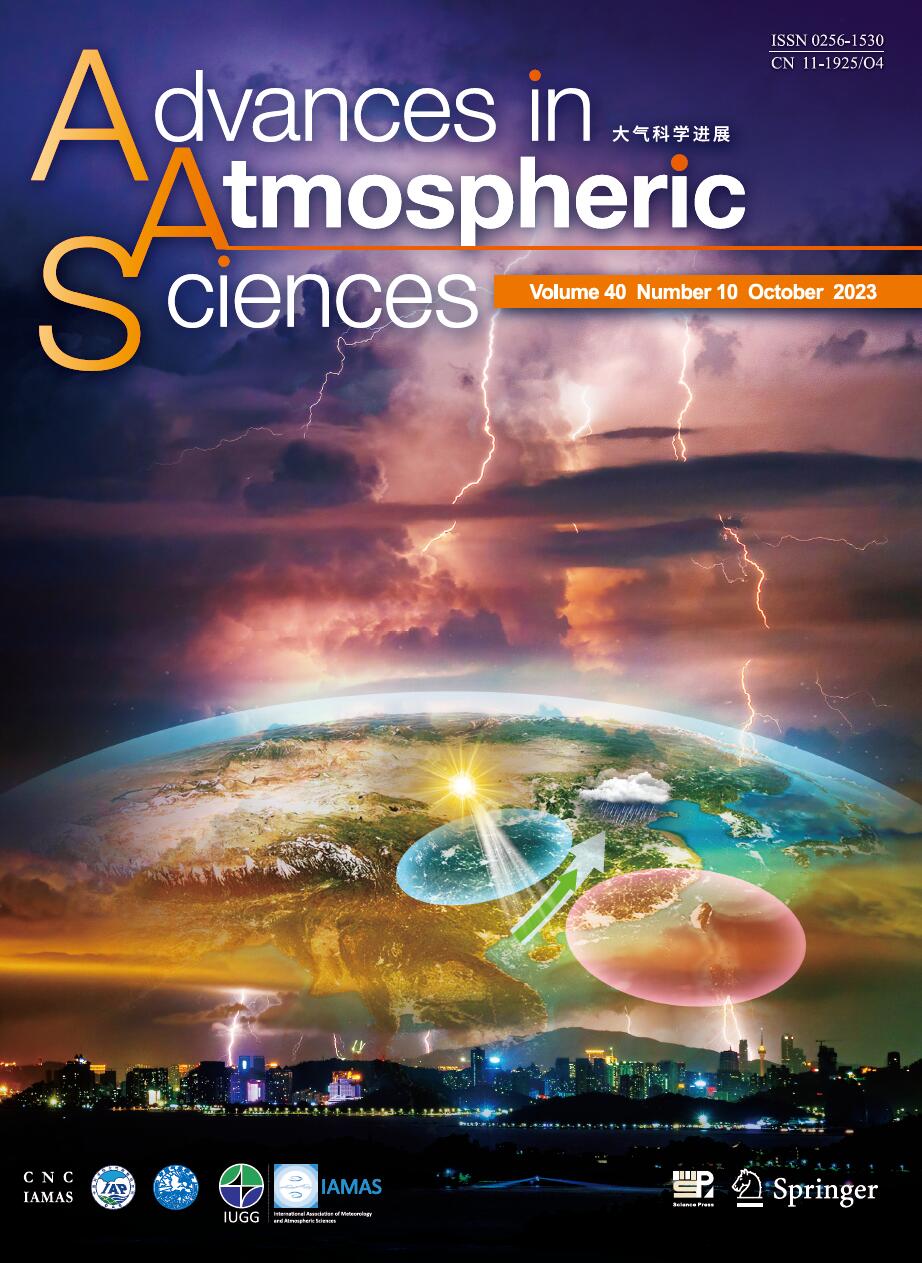| [1] |
Wang Mingxing, Shangguan Xingjian, Shen Renxing, Wassmann Reiner, Seiler Wolfgang,
1993: Methane Production, Emission and Possible Control Measures in the Rice Agriculture, ADVANCES IN ATMOSPHERIC SCIENCES, 10, 307-314.
doi: 10.1007/BF02658136
|
| [2] |
ZHANG Dingyuan, LIAO Hong, WANG Yuesi,
2014: Simulated Spatial Distribution and Seasonal Variation of Atmospheric Methane over China: Contributions from Key Sources, ADVANCES IN ATMOSPHERIC SCIENCES, 31, 283-292.
doi: 10.1007/s00376-013-3018-y
|
| [3] |
Zhang Renjian, Wang Mingxing,
1999: Modeling the Sudden Decrease in CH4 Growth Rate in 1992, ADVANCES IN ATMOSPHERIC SCIENCES, 16, 242-250.
doi: 10.1007/BF02973085
|
| [4] |
BI Yun, CHEN Yuejuan, ZHOU Renjun, YI Mingjian, DENG Shumei,
2011: Simulation of the Effect of an Increase in Methane on Air Temperature, ADVANCES IN ATMOSPHERIC SCIENCES, 28, 129-138.
doi: 10.1007/s00376-010-9197-x
|
| [5] |
Igor Oliveira RIBEIRO, Rodrigo Augusto Ferreira de SOUZA, Rita Valèria ANDREOLI, Mary Toshie KAYANO, Patrícia dos Santos COSTA,
2016: Spatiotemporal Variability of Methane over the Amazon from Satellite Observations, ADVANCES IN ATMOSPHERIC SCIENCES, 33, 852-864.
doi: 10.1007/s00376-016-5138-7
|
| [6] |
Chuanjie YANG, Guang LI, Lijuan YAN, Weiwei MA, Jiangqi WU, Yan TAN, Shuainan LIU, Shikang ZHANG,
2022: Effects of Plant Community Type on Soil Methane Flux in Semiarid Loess Hilly Region, Central Gansu Province, China, ADVANCES IN ATMOSPHERIC SCIENCES, 39, 1360-1374.
doi: 10.1007/s00376-022-1169-4
|
| [7] |
LIU Chunyan, Jirko HOLST, Nicolas BRUGGEMANN, Klaus BUTTERBACH-BAHL, YAO Zhisheng, HAN Shenghui, HAN Xingguo, ZHENG Xunhua,
2008: Effects of Irrigation on Nitrous Oxide, Methane and Carbon Dioxide Fluxes in an Inner Mongolian Steppe, ADVANCES IN ATMOSPHERIC SCIENCES, 25, 748-756.
doi: 10.1007/s00376-008-0748-3
|
| [8] |
Denghui JI, Minqiang ZHOU, Pucai WANG, Yang YANG, Ting WANG, Xiaoyu SUN, Christian HERMANS, Bo YAO, Gengchen WANG,
2020: Deriving Temporal and Vertical Distributions of Methane in Xianghe Using Ground-based Fourier Transform Infrared and Gas-analyzer Measurements, ADVANCES IN ATMOSPHERIC SCIENCES, 37, 597-607.
doi: 10.1007/s00376-020-9233-4
|
| [9] |
ZHENG Xunhua, LIU Chunyan, HAN Shenghui,
2008: Description and Application of a Model for Simulating Regional Nitrogen Cycling and Calculating Nitrogen Flux, ADVANCES IN ATMOSPHERIC SCIENCES, 25, 181-201.
doi: 10.1007/s00376-008-0181-7
|
| [10] |
Zhao Li, Zhao Sixiong,
1995: Numerical Experiments of Meiyu(Baiu) Rainfall by Quasi-Lagrangian Limited Area Model with Terrain, ADVANCES IN ATMOSPHERIC SCIENCES, 12, 57-66.
doi: 10.1007/BF02661287
|
| [11] |
SHEN Shuanghe, YANG Dong, XIAO Wei, LIU Shoudong, Xuhui LEE,
2014: Constraining Anthropogenic CH4 Emissions in Nanjing and the Yangtze River Delta, China, Using Atmospheric CO2 and CH4 Mixing Ratios, ADVANCES IN ATMOSPHERIC SCIENCES, 31, 1343-1352.
doi: 10.1007/s00376-014-3231-3
|
| [12] |
Shutao CHEN, Jianwen ZOU, Zhenghua HU, Yanyu LU,
2019: Climate and Vegetation Drivers of Terrestrial Carbon Fluxes: A Global Data Synthesis, ADVANCES IN ATMOSPHERIC SCIENCES, , 679-696.
doi: 10.1007/s00376-019-8194-y
|
| [13] |
WANG Aihui, ZENG Xubin,
2009: Improving the Treatment of the Vertical Snow Burial Fraction over Short Vegetation in the NCAR CLM3, ADVANCES IN ATMOSPHERIC SCIENCES, 26, 877-886.
doi: 10.1007/s00376-009-8098-3
|
| [14] |
Tido SEMMLER, Thomas JUNG, Marta A. KASPER, Soumia SERRAR,
2018: Using NWP to Assess the Influence of the Arctic Atmosphere on Midlatitude Weather and Climate, ADVANCES IN ATMOSPHERIC SCIENCES, 35, 5-13.
doi: 10.1007/s00376-017-6290-4
|
| [15] |
Yang Xin, Wang Mingxing, Huang Yao,
2001: The Climatic-induced Net Carbon Sink by Terrestrial Biosphere over 1901-1995, ADVANCES IN ATMOSPHERIC SCIENCES, 18, 1192-1206.
doi: 10.1007/s00376-001-0033-1
|
| [16] |
S. PANCHEV, T. SPASSOVA,
2005: Simple General Atmospheric Circulation and Climate Models with Memory, ADVANCES IN ATMOSPHERIC SCIENCES, 22, 765-769.
doi: 10.1007/BF02918720
|
| [17] |
ZHAO Haikun, WU Liguang, ZHOU Weican,
2010: Assessing the Influence of the ENSO on Tropical Cyclone Prevailing Tracks in the Western North Pacific, ADVANCES IN ATMOSPHERIC SCIENCES, 27, 1361-1371.
doi: 10.1007/s00376-010-9161-9
|
| [18] |
JIANG Dabang, DING Zhongli, Helge DRANGE, GAO Yongqi,
2008: Sensitivity of East Asian Climate to the Progressive Uplift and Expansion of the Tibetan Plateau Under the Mid-Pliocene Boundary Conditions, ADVANCES IN ATMOSPHERIC SCIENCES, 25, 709-722.
doi: 10.1007/s00376-008-0709-x
|
| [19] |
Gou Ji, Zheng Xunhua, Wang Mingxing, Li Changsheng,
1999: Modeling N2O Emissions from Agricultural Fields in Southeast China, ADVANCES IN ATMOSPHERIC SCIENCES, 16, 581-592.
doi: 10.1007/s00376-999-0033-0
|
| [20] |
XIE Baohua, ZHOU Zaixing, ZHENG Xunhua, ZHANG Wen, ZHU Jianguo,
2010: Modeling Methane Emissions from Paddy Rice Fields under Elevated Atmospheric Carbon Dioxide Conditions, ADVANCES IN ATMOSPHERIC SCIENCES, 27, 100-114.
doi: 10.1007/s00376-009-8178-4
|















 AAS Website
AAS Website 
 AAS WeChat
AAS WeChat 
 DownLoad:
DownLoad: